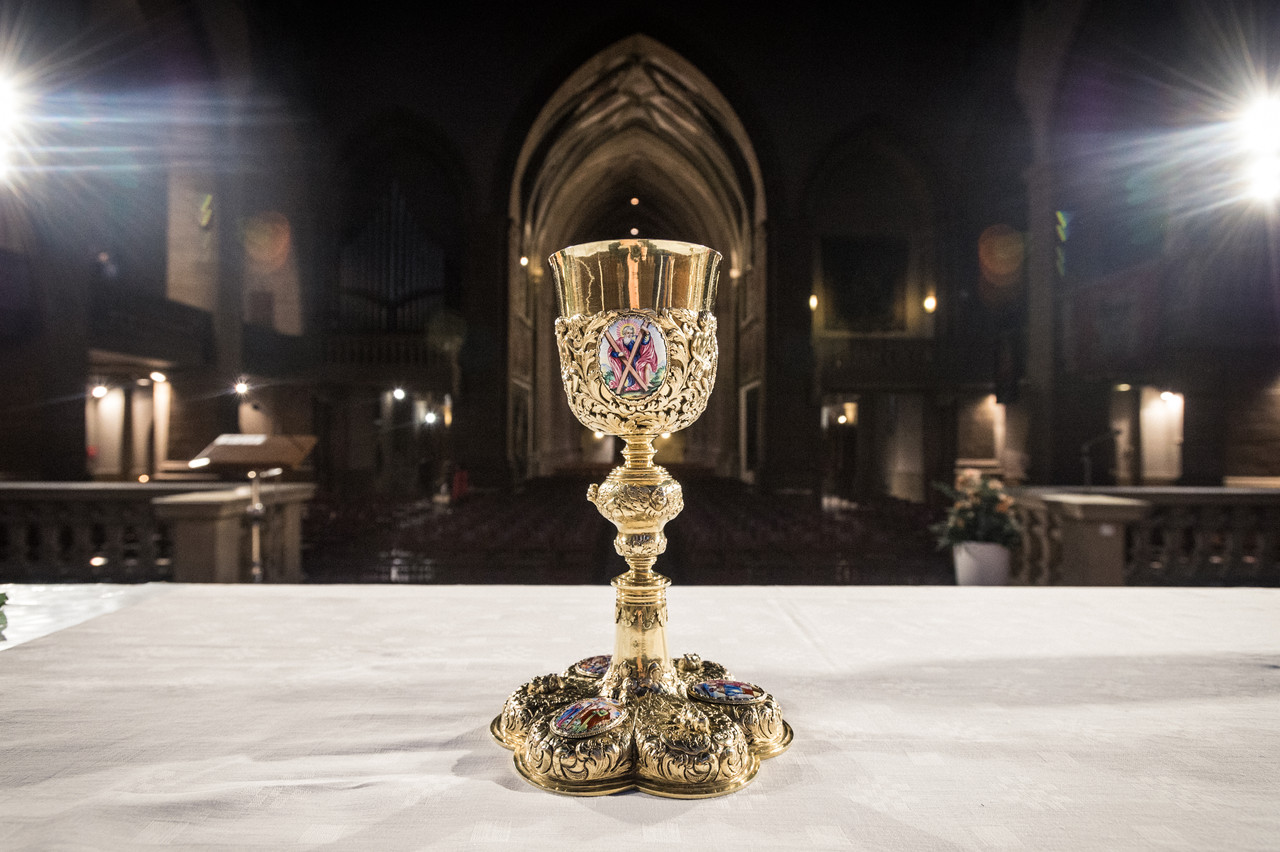The cathedral is sombre, and it immediately envelops you in its neo-gothic sobriety. The cathedral is based on the foundations of the 1621 Jesuit church and school.
The crypt, which is below, has an additional room to the right. Initially, it was foreseen to make this a treasury room during the extension in 1935-1938, but because of the Second World War, that idea was rejected and eventually it became the rehearsal room for the choir. The crypt also bears the remains of Jang de Blannen (John the Blind), who was Count of Luxembourg and King of Bohemia. He died in 1346, but the remains were, after being taken from the chapel in Kastel- Staadt (Germany), laid to rest in the crypt of the Luxembourg cathedral.
The crypt of the Grand Duke’s family is richly decorated by blue and gold mosaics from the Vatican mosaic workshop.
The sacristy is where the priests prepare themselves for mass. The room, which is part of the 1935-38 extension, is expansive and holds their everyday robes. They have different colours, depending on the liturgy: purple is worn during the fasting period and before Christmas, green is the everyday colour, white for all festivities relating to the Virgin Mary and Christmas, and on Pentecost and martyr’s days the priests wear red.
However, there are also some gems among them. Some garments are from the seventeenth century, such as the one embroidered with white pearls, or the red velvet with intricate stitching and embroidery representing religious images and symbols. One was donated by Pierre Ernest de Mansfeld; it was already used in the count’s chapel in the seventeenth century. The drawer with the stoles of the priests contains also many which were gifted, such as the one from Bolivia.
In the capital, mass is held in many languages, reflecting the linguistic diversity of the population: Luxembourgish, French, German and English. Smaller masses are held in the crypt for Italians (twice on Sunday), Slovakians and Opus Dei.
The sacristy also has another room, which contains the robes of the statue of Our Lady of Luxembourg, which is also known as the Comforter of the Afflicted. Mary is the national patron saint of Luxembourg and this particular statue has been revered here since 1624. Her cult culminates in the annual pilgrimage, known as the octave, which starts on the third Saturday after Easter and lasts two weeks. Henrique Boto, sacristan, was keen to show off some of her 63 robes, which are carefully kept in acid-free paper and boxes. He showed us his favourites: a yellow silk nineteenth century robe, which was given by the then governor of Chimay, which she wears for the octave. He presented another one, which was emblazoned with symbols of Luxembourg, popular at a time of rising nationalism across Europe.
Langini explained that many of these robes were re-purposed from old princesses’ brides dresses. These would be transformed into robes for the statue Our Lady of Luxembourg, and quite often would incorporate gifts, such as pendant crosses with semi-precious stones or other pendants. These gifts often represented a thank-you for a prayer that was answered.
The Catholic priests have chalices which they use for the wine. Langini presented a special seventeenth century chalice, which was beautifully decorated with several small enamel panels representing religious scenes.
The windows in the newer part of the cathedral in the chancel were made by Louis Barillet in the late 1930s. The chancel is the space around the altar, including the choir and the sanctuary (sometimes called the presbytery), where the clergy sit in their stalls for big religious events, such as Christmas, Easter or national day. Prominently displayed, above the bishop’s seat, is the famous Our Lady of Luxembourg.
The balcony of the Grand Duke is seldom used now, as the family usually sits in the chancel to the left of the altar. However the windows, which were done between 1935-38, have all been made using a technique from the middle ages to stain glass. In one, you can even spot an image of Melusina above Siegfried, depicting his acquisition of Lucilinburhuc in 963.
At the other end of the cathedral, which is the original 1621 building, you see the impressive Corinthian columns and the seventeenth century tribune with its alabaster iconographies. The organ is actually almost new; it was built in 1995 by local organ manufacturer Westenfelder from Lintgen. There are three organs in the cathedral; Langini explained that Baroque mass was intended to be an encompassing acoustic irradiation, and music was central to the liturgy.
Taking some winding steps up a spiral staircase, the roof truss is truly impressive. The beams, sourced locally, date from the seventeenth century and are now reinforced with steel cables. Small wooden planks lead over the vaulted ceiling.
